Information
-
Document No.
-
Audit Title
-
Client / Site
-
Conducted on
-
Prepared by
-
Location
-
Personnel
-
This report must be completed for ALL incidents even when a detailed report is completed.
This report is to be completed no later than 24 hours after the incident.
Completed forms are to be emailed or faxed to the Executive Assistant.
Event Details (to be completed by the person reporting the incident).
-
Name:
-
Date and time of incident
-
Date and time of investigation
-
Project Name
- KNMIS
- DBIS
- MWS
- SEIS
- LSIS
- WISA
- Meander
- Hagley
- Rubicon
- Sassafrass
- Upper Ringarooma
- Scottsdale
- Headquarters Road
- Southern Highlands
- Swan
- Evandale
- SE Stage 1
- SE Stage 2
- Circular head
-
Manager:
-
Environmental incident details
-
Environmental Impact Details. (Outline app./ communities impacted and extent of impact.). Include photos and drawings as appropriate.
-
Add media
-
Add drawing
-
Environmental incident category (refer to descriptions at the end of this report)
-
Permits in place
- EPBC
- Development Application
- Dam Construction
- Threatened Species
- Aboriginal Heritage
- Forest Practices
- Other
-
Enter other permits in places
-
Involved persons
Person involved
-
Name
-
Phone
-
Email
-
Address
-
Location of incident
-
Is a detailed investigation required for this incident?
-
Investigation to be completed by:
-
Select date
-
Additional information.
-
Have any MNES been impacted?
-
Provide details of MNES impacted
-
Have any State listed species or communities been impacted?
-
Provide details of species / communities impacted.
-
Further action take:
Corrective Actions
-
Remedial actions required
Action:
-
Description of action
-
Who is to complete the action?
-
Action is to be completed by when?
-
Verified action completed by:
-
Date action completed
Review and sign off
-
Project / scheme manager
-
Select date
-
Manager / Supervisor
-
Select date
-
Environmental Manager
-
Select date
-
Report is to be emailed / forwarded to the Environment Manager
Corrective Actions
-
Remedial actions required
Action:
-
Description of action
-
Who is to complete the action?
-
Action is to be completed by when?
-
Verified action completed by:
-
Date action completed

















